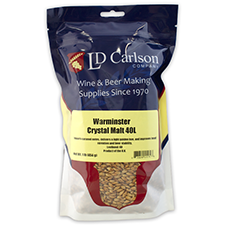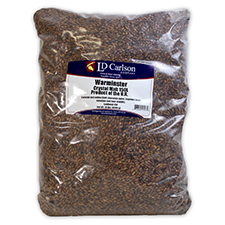Crystal Malt: Adding a Splash of Color and a Dash of Sweetness
Posted by Matteo Lahm on 14th Mar 2024
If you're looking to add a little pizzazz to your pint, let's talk about the magic of crystal malt. It's like the fairy dust of the beer world, adding color, flavor, and a certain je ne sais quoi to your brew.
Crystal malt, also known as the chameleon of the beer world, is a specialty grain that can add a whole spectrum of color to your beer, from a subtle blush to a deep mahogany. It's like the Bob Ross of malts, adding happy little colors to your brew. The color is rated in degrees Lovibond (°L), ranging from 40 °L to around 200 °L. So, whether you're going for a pale ale or a dark stout, there's a crystal malt for you.
But it's not just about looks. When you are sizing up a beer, it is like a first date. Though appearances can be deceiving, this is not the case with Crystal malt. It is that hot gal or guy who comes with some substance, because it is also a flavor powerhouse. It's like the Willy Wonka of the beer world. It adds a sweet, caramel flavor to your brew, and it tastes as good as it looks. This sweetness is a key characteristic of several beer styles, most notably in pale ales. So, if you're looking to brew a beer that's as sweet as a grandma's love, crystal malt is your go-to.
As for how crystal malt gets its name, it is not because it's made by elves in a crystal castle. It's actually due to a unique process. Unlike pale malts, crystal malts are stewed in a closed system that doesn't allow moisture to escape. This process breaks down the starches of the barley grains into sugars, resulting in a crystalline, sugary interior. Hence, the name "crystal malt".
When it comes to using crystal malt, it's as straightforward as following a grandma's pie recipe. The first step in this brewing ballet is to crush the grains. This is not about venting your frustrations on the poor grains, but rather breaking them down to expose their sugary interiors. If you don't have a grain mill, don't sweat it, we can crush them for you prior to shipment.
Once your grains are crushed and ready, it's time to steep them. This is akin to making a cup of tea, but instead of a calming chamomile, you're brewing a boisterous beer. You'll want to heat your brewing water to between 150–160 °F (66–71°C). That's the sweet spot where the magic happens, extracting the color and flavor from the grains without extracting unwanted harshness. When we talk about "unwanted harshness,” we're referring to the extraction of tannins from the grain husks. Tannins are naturally occurring compounds found in many plants, including barley. In the right amounts, they can add complexity and balance to a beer. However, if too many are extracted, they can impart a harsh, astringent flavor - think of oversteeped tea or a really dry red wine.
Now, don't rush this process. Steep the grains for a good 15 minutes. This isn't a quick dip in the pool, it's more like a relaxing soak in a hot tub. Stir every five minutes or so to ensure the color and sweetness are evenly distributed so you have an ongoing sense of the overall color.
After the steeping time is up, lift the grain bag out of the pot with a large kitchen strainer. This is like panning for gold, but instead of shiny nuggets, you're left with a rich, flavorful liquid that's going to become your beer. You can then rinse the grains with hot water to extract any remaining sugar and color. This is like giving the grains a final squeeze to get every last bit of goodness out of them.
Now, here's where things get a bit scientific. The amount of color contributed by the crystal malt can be calculated using a formula involving homebrew color units (HCU). But don't worry, you don't need to be Einstein to figure this out. Just remember, the more crystal malt used in a recipe, and the higher the Lovibond rating, the darker the color.
As for flavor, if you're brewing a beer style that doesn't call for sweetness, like a Scotch ale or a milk stout? In that case, you might want to skip the crystal malt. These styles achieve their sweetness through other methods, like yeast choice and adding unfermentable sugars. So, while crystal malt is a versatile player, it's not always the Oscar winner for best supporting actor.
This is also why crystal malt is always used as a secondary adjunct and is never the primary grain source. With its unique stewing and kilning process, it has already had its starches converted into sugars. This means it doesn't contribute significantly to the fermentable sugars in the wort. It's like adding a sugar cube to your coffee - it sweetens the deal, completes the flavor but has no impact whatsoever on the caffeine kick.
Furthermore, while the sweet, caramel flavors of crystal malt can be a delightful addition to certain beer styles, using it as a primary ingredient could result in a beer that's overly sweet and unbalanced. It's like eating a whole bag of candy - it might seem like a good idea at first, but you'll probably regret it later.
So, while crystal malt is a fantastic supporting actor, adding depth and complexity to your brew, it's not typically cast in the leading role. But hey, that's the beauty of brewing - you're the director, and you get to decide what goes into your beer. When it comes to crystal malt, it's all about finding the right balance. Too little, and you might not notice its sweet, caramel charm. Too much, and your beer might end up tasting like Halloween rice balls with too much sugar.
Typically, crystal malt makes up between 5% to 20% of the total grain bill. This range isn't set in stone, but it's a good starting point. For lighter beers like pale ales, bitters, or ESBs, you might use up to 20% crystal malt. This gives the beer a nice, sweet undertone without overpowering the other flavors. For darker ales, such as porters and stouts, you might use less crystal malt, as these beers also contain more darkly roasted grains. And for lagers like Octoberfests or Vienna lagers, you might use up to 15% crystal malt. So, feel free to experiment and find the perfect balance for your brew.
In conclusion, now you know the ins and outs of Crystal malt – a splendid malted grain that adds color and flavor to your brew. Whether you're a newbie homebrewer or a seasoned pro, adding crystal malt to your beer recipe is a surefire way to brew a beer that's a feast for the eyes and the palate. So, go ahead and experiment with crystal malt. After all, variety is the spice of life, and in this case, the spice of beer. Cheers!



